The Karnataka leg of the National Cultural Jatha under the slogan Dhaai Aakhar Prem was held from Dec 2, 2023 to Dec 7, 2023, traversing from Mangaluru, the headquarters of Dakshina Kannada district, to Manjeshwar, across the border in Kasaragod district of Kerala state. The six day Jatha was a grand success, achieving much more than what was sought when it was mooted. It was held peacefully, with the spirited participation of all sections of political, religious and social strata, showcasing and abiding by the motto of Dhai Aakhar Prem, in letter and spirit.
The present Dakshina Kannada district is carved out of the erstwhile South Canara district, which was under the Madras Presidency during the British rule, and extended from the river Payaswini, now in Kasaragod of Kerala state, to Kundapur, now a part of the Udupi district, that lies to the north of Dakshina Kannada district in Karnataka state. Areas under South Canara district have always been known for the confluence of Kannada, Tulu, Malayalam and Konkani languages and the very rich traditions, rituals and cuisines of the people speaking these languages. The erstwhile South Canara, and now Dakshina Kannada and Udupi districts, have always prided to be the ‘districts of the intelligent’, and have been ahead since pre-independence times to till date in education, banking, social and economic development, industrialisation, and syncretic and harmonious living of the multiple cultures, languages and communities. But sadly in the past 2 decades, the ascent of communal politics in the districts has tarnished the image of the districts, with frequent attacks on youth under the guise of ‘moral policing’, hate mongering against minorities, and communal polarisation, and rising fundamentalism even among professionals and the media and all these significantly restricting the space for progressive and secular engagements.
On this backdrop, the decision to hold the Karnataka leg of Dhai Aakhar Prem Cultural Jatha in Dakshina Kannada district surely incited a sense of honour as well as concern – honour for being chosen, in consideration of the rich heritage and history, and concern about the ability of the dwindling numbers of the activists to organise a programme of this scale. But it has been a very humbling, greatly satisfying and encouraging experience that everyone that we counted upon stood up to the occasion and delivered much much more than what was anticipated, making the Jatha a very successful, fulfilling and historic event.
The Jatha for Karnataka in Dakshina Kannada was conceptualised to include the rich history, heritage, culture, rituals, cuisines, scenic localities and experiences that the district is known for. A reception committee was formed under the chairpersonship of Dr Sabiha Bhoomigowda, former vice-chancellor of Akkamahadevi Women’s University and a writer, thinker and activist for progressive and women’s causes. The committee included more than 45 intellectuals, academicians, scholars, writers, thinkers, artists and activists, with Dr Srinivas Kakkilaya, physician at Mangaluru, as co-ordinator and Nagesh Kallur, publisher, writer and activist, as the secretary.
The Karnataka Jatha in Dakshina Kannada was named as Rashtriya Sanskrutika Yatre. To the motto of the national jatha, Dhai Aakhar Prem, the words Pattappe Jōkulu Onjē Matteld, stated by the local deities, was added. Pattappe Jōkulu Onjē Matteld translates to Children of Ten Mothers Come on One Lap, a call by the deities to unite and protect all the people of all religions and sects and languages. For the logo of the Yatre, the reception committee also added the image of Sri Narayana Guru, well known saint, philosopher and poet who had inspired Mahatma Gandhi and Ravindranath Tagore, along with those of Bhagat Singh, Mahatma Gandhi and Kabir.
 As we proceeded with the plans for the Yatra, programmes at each of the sites that we planned to visit along the route kept evolving as stand-alone programmes. Reception committee members enthusiastically volunteered to take responsibility to organise programmes at the sites closer to or associated with themselves. The response from the local people and others was such that till the last minute, guests and speakers’ list kept on enlarging. All these programems were arranged and funded by the local organisers themselves, and the reception committee did not have to go on any fundraising efforts nor had to use or open any bank account! For the musical programmes, most of the artists volunteered to sing/play voluntarily without charging any fees, and the expenses for the equipment were borne by a couple of well wishers who refused to get acknowledged. Similarly, arrangements for the stay of the Yatris were made by the local organisers themselves, and in every programme, food was served by the local organisers.
As we proceeded with the plans for the Yatra, programmes at each of the sites that we planned to visit along the route kept evolving as stand-alone programmes. Reception committee members enthusiastically volunteered to take responsibility to organise programmes at the sites closer to or associated with themselves. The response from the local people and others was such that till the last minute, guests and speakers’ list kept on enlarging. All these programems were arranged and funded by the local organisers themselves, and the reception committee did not have to go on any fundraising efforts nor had to use or open any bank account! For the musical programmes, most of the artists volunteered to sing/play voluntarily without charging any fees, and the expenses for the equipment were borne by a couple of well wishers who refused to get acknowledged. Similarly, arrangements for the stay of the Yatris were made by the local organisers themselves, and in every programme, food was served by the local organisers.
The Yatre was thus oragnised without the name of a single organisation or the names of the reception committee being mentioned on th eBrochure. It was thus a Yatre without any organisation or person named, but every organisation and person participating; no fundraising happened, but enough money was spent for the programmes, for stay and for food. all locally! Indeed, it turned out to be a very memorable experience for everyone who participated.
Day 1, December 2, Saturday
9am, Inauguration at Sri Kudmul Ranga Rao Memorial, Babugudde, Mangaluru
The Dhai Aakhar Prem – Pattappe Jōkulu Onjē Matteld National Cultural Jatha – Karnataka in Dakshina Kannada was inaugurated at 9am at the Samadhi Sthal of Sri Kudmul Ranga Rao, located at the Brahmo Samaj cemetery at Babugudde in Mangaluru. Sri Kudmul Ranga Rao (1859-1928), whom Mahatma Gandhi acknowledged as a teacher for the upliftment of untouchables, was known as Dalitoddharak, and had opened many schools and hostels for the most backward children, provided them mid-day meals, and also pioneered social reforms by encouraging widow marriages and girls’ education.
The inaugural function was organised under the leadership of Dr. Mugalavalli Keshava Dharani, retired official at the transport office and a poet and scholar. Solemn arrangements were in place for the occasion, and refreshments were served. The programme began with the recitation of Dhai Aakhar Prem by theatre activists Prabhakar Kapikad and Shyamsundar Rao and Shanmukhaswamy, Karnataka state secretary of IPTA. A bhajan on Sri Kudmul Ranga Rao, written by Radha Teacher, was sung by Devendra and Kiran of the Kudmul Ranga Rao Memorial Samithi, Kapikad, Mangaluru. The inauguration of the Yatre was marked by paying floral tributes to the Samadhi of Sri Kudmul Ranga Rao by all the participants, led by Sri Prasanna. Welcoming the participants, Dr Keshava Dharani appreciated the gesture of choosing Kudmul Ranga Rao’s memorial as the most apt site for inauguration of the yatra, as the flag of the Depressed Classes Mission, started by Kudmul Ranga Rao, depicted a house with three persons of Hindu, Muslim and Christian communities standing unitedly with hands held. He also hailed the greatness of Kudmul Ranga Rao by drawing attention to his words ‘A Dalit boy who studies in my school should join public service and his car should move around on our village roads, when the dust that then rises touches my head, I shall consider my life worthwhile’ that are etched on his Samadhi, and reminding that when Sri Rao spoke of such a dream in 1911, there were only 3 cars in all of India. Sri Prasanna, national President of IPTA, paid rich tributes to Sri Kudmul Ranga Rao and requested the authorities to maintain the peace, natural surroundings and tranquillity of the site. Dr Venugopal Shetty, Professor of Kananda at Alva’s College, Moodabidri, spoke on the sacrifices made by Sri Kudmul Ranga Rao in his zest to help the last of the downtrodden and untouchables and narrated how he had inspired Mahatma Gandhi, Rajaji and other national leaders to take up the task of emancipating the untouchables and dalits.



10am – Basel Mission Compound, Balmatta:
 The next destination of the Yatre was at the Basel Mission Compound in Balmatta, Mangaluru. The Yatre was welcomed by Dr HM Watson, other staff and students of Karnataka Theological College. After the introductory remarks by Dr Watson, the yatris, led by Sri Prasanna, Dr Siddanagouda Patil and Dr Sabiha Bhoomigowda, paid floral tributes at the statue of Rev. Ferdinad Kittel (1832 –1903). Sri Prasanna spoke about the immense contributions of Rev Kittel and recalled how, on his travels across the state as a priest of the Basel Mission, riding on his horse, he collected thousands of Kannada words by intently listening to the conversations of the people at markets and other places and in 1894 compiled the mammoth Kannada-English lexicon of 70000 words that remains the gold standard even to this day. Dr Siddanagouda Patil, editor of Hosathu monthly, Kannada scholar, writer and activist, praised the immense contributions of Rev Kittel, and mentioned about his extraordinary work of translating into English Nagarjuna’s Shabda Mani Darpana, the most difficult book on Kannada grammar. Thereafter, the students of the Karnataka Theological College sang a song in praise of Rev Kittel. Later, the Yatris, led by Dr Sabiha Bhoomigowda, Prasanna and Dr Siddanagouda Patio, paid floral tributes to Rev. Hermann Mogling (1811–1881) at his bust. Rev. Hermann Mogling was the publisher of Mangalooru Samachara in 1843, the first ever newspaper of Kannada language. The archives of the Basel Mission Press, Mangaloora Samachara, Kittel’s dictionary and other materials used at the Press were kept open for the visit of the Yatris. The Yatris were served refreshments by the College.
The next destination of the Yatre was at the Basel Mission Compound in Balmatta, Mangaluru. The Yatre was welcomed by Dr HM Watson, other staff and students of Karnataka Theological College. After the introductory remarks by Dr Watson, the yatris, led by Sri Prasanna, Dr Siddanagouda Patil and Dr Sabiha Bhoomigowda, paid floral tributes at the statue of Rev. Ferdinad Kittel (1832 –1903). Sri Prasanna spoke about the immense contributions of Rev Kittel and recalled how, on his travels across the state as a priest of the Basel Mission, riding on his horse, he collected thousands of Kannada words by intently listening to the conversations of the people at markets and other places and in 1894 compiled the mammoth Kannada-English lexicon of 70000 words that remains the gold standard even to this day. Dr Siddanagouda Patil, editor of Hosathu monthly, Kannada scholar, writer and activist, praised the immense contributions of Rev Kittel, and mentioned about his extraordinary work of translating into English Nagarjuna’s Shabda Mani Darpana, the most difficult book on Kannada grammar. Thereafter, the students of the Karnataka Theological College sang a song in praise of Rev Kittel. Later, the Yatris, led by Dr Sabiha Bhoomigowda, Prasanna and Dr Siddanagouda Patio, paid floral tributes to Rev. Hermann Mogling (1811–1881) at his bust. Rev. Hermann Mogling was the publisher of Mangalooru Samachara in 1843, the first ever newspaper of Kannada language. The archives of the Basel Mission Press, Mangaloora Samachara, Kittel’s dictionary and other materials used at the Press were kept open for the visit of the Yatris. The Yatris were served refreshments by the College.
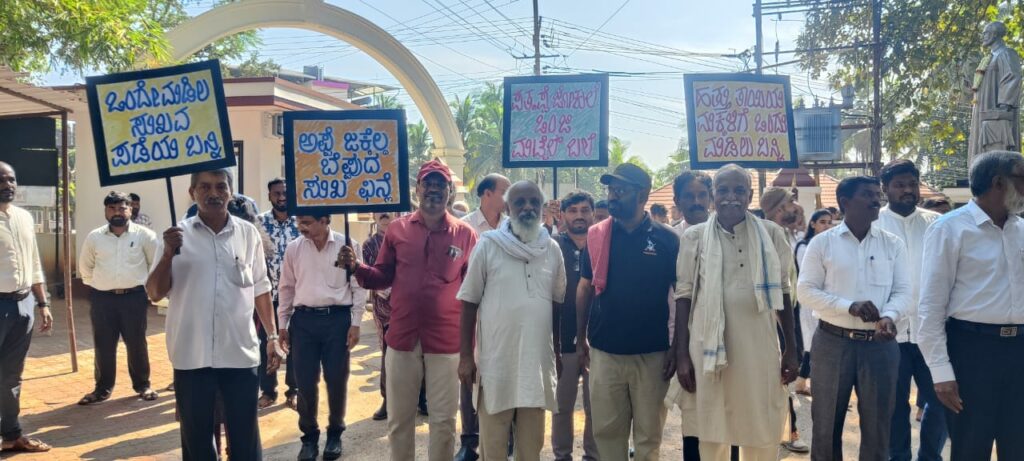

9.30am onwards at Mahila Sabha, Baba Saheb Ambedkar Circle, Balmatta
The Mahila Sabha, Mangaluru, was established in 1911 by Desh Bhakt Karnad Sadashiv Rao, his wife Shanta Bai, Girija Bai, mother of Kamaladevi Chattopadhyay and others for emancipation of women, particularly to impart vocational training to child windows and women. The then British government had donated 1.2 acres of land to the Mahila Sabha where its buildings stand testimony to the great deeds of these freedom fighters and reformers. However, the structures and the land are under threat of demolition owing to the Smart City project of Mangaluru.
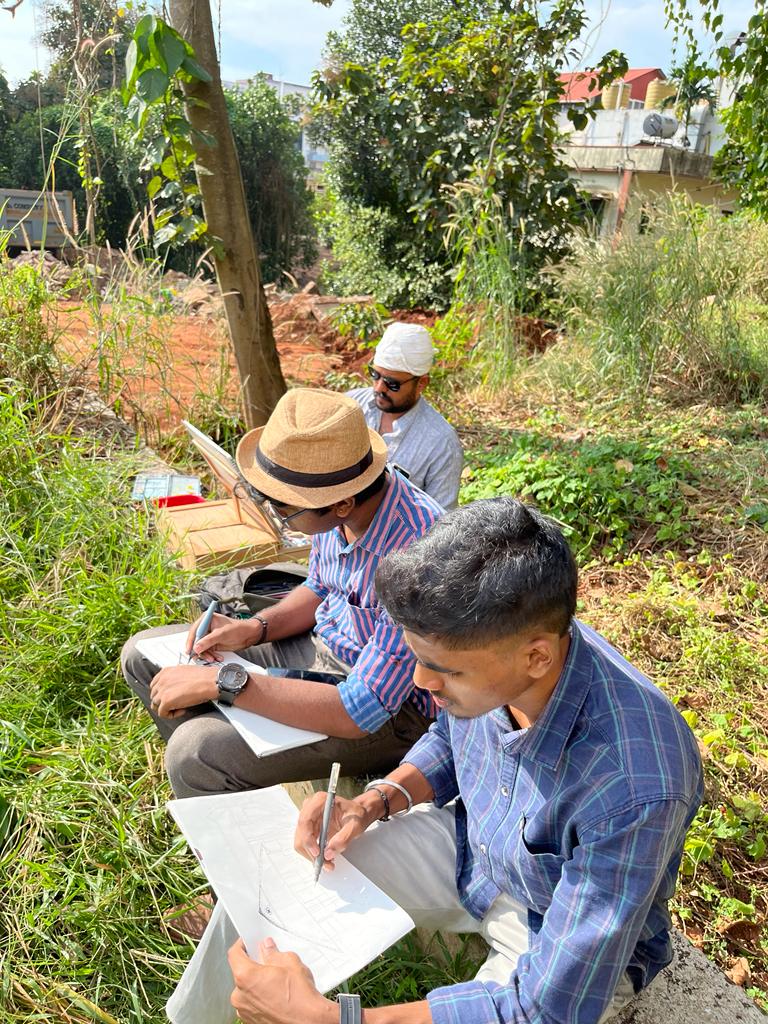 Dhai Aakhar Prem Yatre paid tributes to these stalwarts by organising meaningful programmes at the site. Members of the Art Kanara Trust and INTACH unit at Mangaluru, led by Subhashchandra Basu, President of Art Kanara Trust and Convenor of INTACH, Mangaluru Chapter, Rajendra Kedige and Nemiraj Shetty, conducted a Heritage Conservation Art Workshop at the Mahila Sabha, starting at 9.30am. Artists Wilson Souza, Santhosh Andrade, Sujith K V and Vivek A R participated. As the Yatris reached the venue, members of the Mahila Sabha, led by its president Vijayalakshmi Rai, and the members of ACT and INTACH, welcomed them. Vijayalakshmi Rai explained the ideals of establishing the Mahila Sabha and paid tributes to the founders and to Kamaladevi Chattopadhyaya, the daughter of Mangaluru who played a stellar role in our freedom struggle and thereafter, worked tirelessly for reviving and strengthening Indian handicrafts and handlooms and all art forms. Sri Prasanna lauded the sacrifices made by these great people and called for conserving and strengthening the institutions built by them.
Dhai Aakhar Prem Yatre paid tributes to these stalwarts by organising meaningful programmes at the site. Members of the Art Kanara Trust and INTACH unit at Mangaluru, led by Subhashchandra Basu, President of Art Kanara Trust and Convenor of INTACH, Mangaluru Chapter, Rajendra Kedige and Nemiraj Shetty, conducted a Heritage Conservation Art Workshop at the Mahila Sabha, starting at 9.30am. Artists Wilson Souza, Santhosh Andrade, Sujith K V and Vivek A R participated. As the Yatris reached the venue, members of the Mahila Sabha, led by its president Vijayalakshmi Rai, and the members of ACT and INTACH, welcomed them. Vijayalakshmi Rai explained the ideals of establishing the Mahila Sabha and paid tributes to the founders and to Kamaladevi Chattopadhyaya, the daughter of Mangaluru who played a stellar role in our freedom struggle and thereafter, worked tirelessly for reviving and strengthening Indian handicrafts and handlooms and all art forms. Sri Prasanna lauded the sacrifices made by these great people and called for conserving and strengthening the institutions built by them.

10.30am: Tagore Park
This landmark at the head of Mangaluru on the Light House Hill, was built by Hyder Ali, Sultan of Mysore (1761–1782), nurtured by his son Tipu Sultan, lighted by the British with an acetylene lamp, visited by Gurudev Tagore, and hence named after him, has stood witness to the freedom struggle and has been the starting point of the various struggles and workers’ processions in Mangaluru. It also has the building now hosting the Mahatma Gandhi Shanti Pratishtan.


The programme here was organised under the leadership of Sri Ismail N, Secretary of Mahatma Gandhi Shanti Pratishtan and other office bearers and members, in association with Gandhi Vichara Vedike of Dakshina Kannada. Aravinda Chokkadi, teacher and thinker, and author of the book on Karnad Sadashiva Rao, titled Kabeeranaada Kubera (Kubera who became Kabeera), paid rich tributes to Karnad Sdashiva Rao. Recalling how KS Rao, a very wealthy lawyer who could have bought half of Mangaluru at the time, gave his everything for his country and people during the freedom struggle and died in utter penury. He also reminded that it was KS Rao who goaded Mahatma Gandhi on his return from South Africa to continue his Satyagraha for freeing India and was the first one to bring the Congress Party to South Canara and to sign the petition for Satyagraha. Prabhakara Sharma, retired additional deputy commissioner, Anna Vinayachandra, ex-MLC, Prasanna, Prof. Sabiha Bhoomigowda, Prof. Shivaram Shetty, Pro. Xavier DSouza, Sadanada Shetty, President of Gandhi Shanti Pratishtan, Ibrahim Kodijal, its former vice-president and many others were present on the occasion. The programme concluded with garlanding Mahatma Gandhi and K Sadashiva Rao.
11.30am Temple Square, Car Street
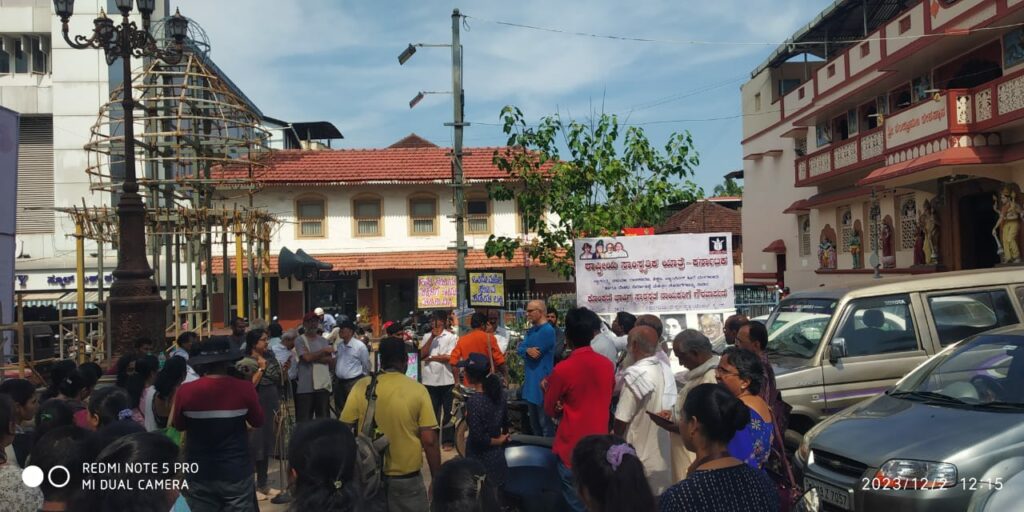
 Dhai Aakhar Prem – Pattappe Jōkulu Onjē Matteld National Cultural Jatha thereafter proceeded to the Temple Square at Car Street, where Sri Venkataramana Temple, the presiding deity of the Konkani speaking Saraswats is situated, and every year, the traditional car festival is celebrated. The Konkani speaking Saraswats form a significant section of the people of Dakshina Kannada district and have contributed immensely during the freedom struggle and nation building. The programme at the Temple Square was conceptualised and organised by Prof. Narendra Nayak, national President of the Federation of Indian Association of Rationalists Association (FIRA) and a well known thinker and activist.
Dhai Aakhar Prem – Pattappe Jōkulu Onjē Matteld National Cultural Jatha thereafter proceeded to the Temple Square at Car Street, where Sri Venkataramana Temple, the presiding deity of the Konkani speaking Saraswats is situated, and every year, the traditional car festival is celebrated. The Konkani speaking Saraswats form a significant section of the people of Dakshina Kannada district and have contributed immensely during the freedom struggle and nation building. The programme at the Temple Square was conceptualised and organised by Prof. Narendra Nayak, national President of the Federation of Indian Association of Rationalists Association (FIRA) and a well known thinker and activist.

After welcoming the Yatre, Prof. Narendra Nayak stressed on the need for harmony and peaceful co-existence. A banner depicting the images of Kudmul Ranga Rao, Radhabai Kudmul, Karnad Sadashiva Rao, Umabai Kundapura and Kamaladevi Chattopadhyay, the best known freedom fighters and reformers who sacrificed and worked tirelessly for the emancipation of the mst backward communities and women, and of A Shantaram Pai, a freedom fighter, well known trade union activist, who during the freedom struggle worked as the nerve centre of the underground network of the Communist Party of India under the leadership of PC Joshi in Mumbai, Ullal Srinivas Mallya, the first member of parliament from Dakshina Kannada who is credited as the architect of modern Mangaluru and Ammembal Subba Rao Pai, the founder of Canara educational institution and the Canara Bank, was erected at Temple Square on the occasion. On behalf of the organisers and the Yatre, Manjula Nayak paid rich tributes to all the stalwarts for their immense contributions to our society. More than 125 participants were treated with sumptuous traditional Konkani dishes such as Muga usli (boiled green gram, fresh coconut, seasoned with chillies), Chane upkari (Black chickpeas, grated coconut, chillies and spices), Phova chatni (Rice flakes, grated coconut, chillies and spices), Kananga chips (sweet potato wafers) and Panaka (spiced beverage).
2pm – Dhakke – The Fishing Yard at Old Port

 In the afternoon, the first stop was at Mangaluru Dhakke, the fishing yard at the old port. Dhakke and the Bunder (Port) area of Mangaluru are a symbol of harmonious coexistence of languages, communities, cultures, and the workforce since long. The participants of Dhai Aakhar Prem Yatre, led by Dr Siddanagauda Patil, Saathi Sundaresh, Amjad, Shanmukhaswamy, all from IPTA, Karnataka, and Bharathi Prashanth, Secretary of NFIW, Karnataka, Suresh Kumar Buntwal, Karunakar Maripalla, Seetharam Berinja, Thimmappa, and others from IPTA, Dakshina Kannada, interacted with the fishermen and women and sang songs of harmony, love and coexistence.
In the afternoon, the first stop was at Mangaluru Dhakke, the fishing yard at the old port. Dhakke and the Bunder (Port) area of Mangaluru are a symbol of harmonious coexistence of languages, communities, cultures, and the workforce since long. The participants of Dhai Aakhar Prem Yatre, led by Dr Siddanagauda Patil, Saathi Sundaresh, Amjad, Shanmukhaswamy, all from IPTA, Karnataka, and Bharathi Prashanth, Secretary of NFIW, Karnataka, Suresh Kumar Buntwal, Karunakar Maripalla, Seetharam Berinja, Thimmappa, and others from IPTA, Dakshina Kannada, interacted with the fishermen and women and sang songs of harmony, love and coexistence.
4.30pm – Sri Gokarnanatheshwara Temple:
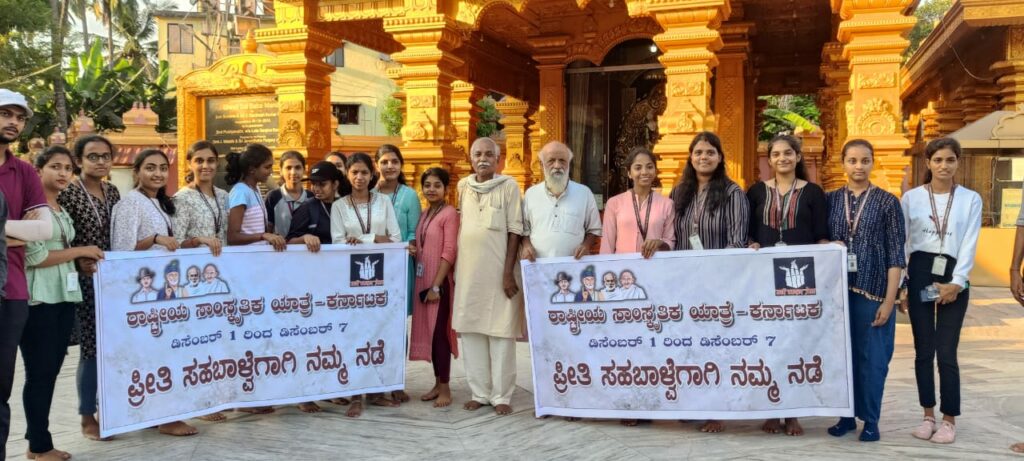 The Yatre then proceeded to Sri Gokarnanatheshwara Temple at Kudroli. Built in 1912 and consecrated by Sri Narayana Guru, saint, reformer and poet, it’s one of the oldest temples in the region, where the true ideals of Sri Narayana Guru are brought into practice, with women and widows also acting as archakas and people of all communities, religions and sections volunteering, particularly during the famous Mangaluru Dasara that is organised by the Temple every year. As part of the Dhai Aakhar Prem – Pattappe Jōkulu Onjē Matteld National Cultural Jatha, a programme of Bhakti Sangeet by Imthiyaz Sultan, well known singer of Karnataka, was arranged with help from a well wisher donor. The Bhakti Sangeet indeed enthralled the audience present and Prasanna, national President of IPTA, was seen completely immersed in it. Padmaraj, a prominent member of the temple management trust, welcomed the participants, and later, honoured the artists. Premanath and Jagat Pal of IPTA had assisted in organising this event.
The Yatre then proceeded to Sri Gokarnanatheshwara Temple at Kudroli. Built in 1912 and consecrated by Sri Narayana Guru, saint, reformer and poet, it’s one of the oldest temples in the region, where the true ideals of Sri Narayana Guru are brought into practice, with women and widows also acting as archakas and people of all communities, religions and sections volunteering, particularly during the famous Mangaluru Dasara that is organised by the Temple every year. As part of the Dhai Aakhar Prem – Pattappe Jōkulu Onjē Matteld National Cultural Jatha, a programme of Bhakti Sangeet by Imthiyaz Sultan, well known singer of Karnataka, was arranged with help from a well wisher donor. The Bhakti Sangeet indeed enthralled the audience present and Prasanna, national President of IPTA, was seen completely immersed in it. Padmaraj, a prominent member of the temple management trust, welcomed the participants, and later, honoured the artists. Premanath and Jagat Pal of IPTA had assisted in organising this event.


5.30pm – Sulthan Bathery
The Yatre reached Sulthan Bathery towards evening. This watch tower built by Tipu Sultan in 1784, stands at the confluence of Netravati and Gurpur rivers with the Arabian Sea, standing testimony to strength, courage, and harmonious confluence of cultures and traditions. The programme at Sulthan Bathery was organised by the Karavali Lekhakiayara Vachakiyara (writers and readers) Sangha, in association with Mogaveera Maha Sabha, Bolar (Fishermen’s Association). The Jatha was welcomed by the office bearers and members of Karavali Lekhakiayara Vachakiyara Sangha, and Mogaveera Maha Sabha, led by Jyothi Chelyaru, and Yashavant Mendon,, President of the Mogaveera Maha Sabha. Dr. Shaila U paid tributes to Rani Abbakka, the Queen of Ullal (1525-1570) who united her people and valiantly fought and defeated the Portuguese invaders. Felcy Lobo and Vilita Lobo sang Konkani poetry, and Rathnavathy Baikady presented Tulu songs. Yashavant Mendon narrated the lifestyles of the fishermen and the harmonious coexistence, struggles and labour of the working class across religious divide. Prasanna and Dr. Sabiha Bhoomigowda also spoke on the occasion. Artist Pradeep had decorated the site and prepared placards in arecanut leaves. Jagadish Bolar had made the arrangements for the event, supported by the Mogaveera Maha Sabha.

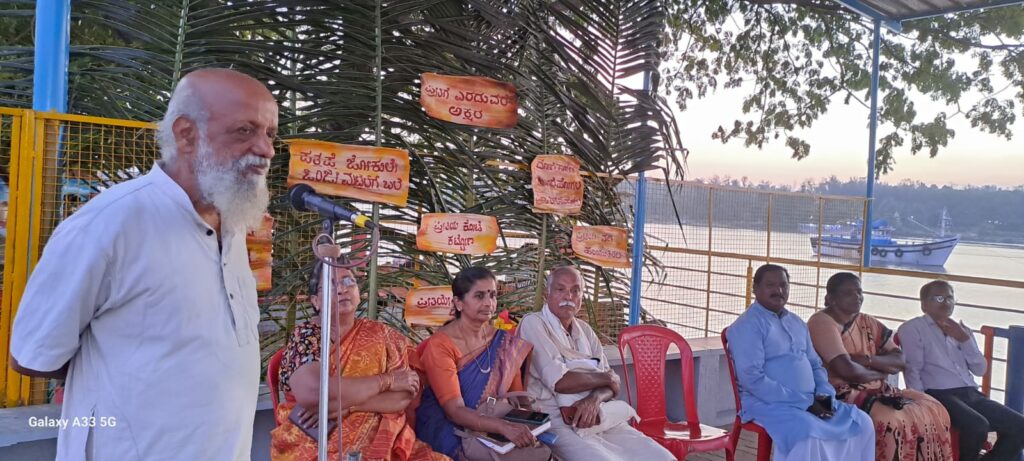

6.30pm Tanneerbhavi beach, across the river from Sulthan Bathery
After the programme at Sulthan Bathery, the Jatha participants got into the boats provided by the Mogaveera Maha Sabha and sailed across the Nethravathi river to the Thanneerbhavi beach where a musical evening at sunset was organised by Karavali Byari Artists Association, under the leadership of Hussain Katipalla and UH Khalid Ujire, in association with Muhammed Iqbal Katiappalla, a well known singer. The arrangements were sponsored by well wishers.

Sri Mahesh Kumar, assistant commissioner of police (crime, law and order) of Mangaluru, was the chief guest. Lauding the Jatha and its ideals, he called for strengthening the unity, brotherhood and peace and suggested organising more programmes to achieve these goals. Prasanna, Dr Sidanagouda Patil, Dr Sabiha Bhoomigowda, Mohammed Ali Uchil, President of Byari Welfare Forum, Abu Dhabi, Dr Zakir Yusuf Hussain, Ayaz Kaikamba, Basheer bykampadi, former deputy mayor, KP Panikker, former corporator graced the occasion and spoke. Ganesh, Rony Crasta, Rishal Crasta, Muhammed Iqbal, Ashfaq Katipalla, Faiz Katipalla, Khalid, Manohar, Azhar Dajin sang songs of harmony in Kannada, Tulu, Konkani, Byari, Malayalam and Hindi. The programem was compered by Samad Katipalla, a well known artist. This 3 hour memorable programme was a fitting finale for the very eventful first day of the Yatre in Mangaluru.
Day 2 – Dec 3, Sunday
9.00am – Brahma Baidarkala Garadi, Nagori

The second day of the Yatre began at Shree Brahma Baidarkala Garadi Kshetra in Nagori, Mangaluru. This Kshetra is a temple dedicated to the twin cultural heroes of Tulu Nadu region, Koti and Chennayya (1556-1591). The premises also has a unique temple dedicated to Mahatma Gandhi, his idol offered pooja everyday.


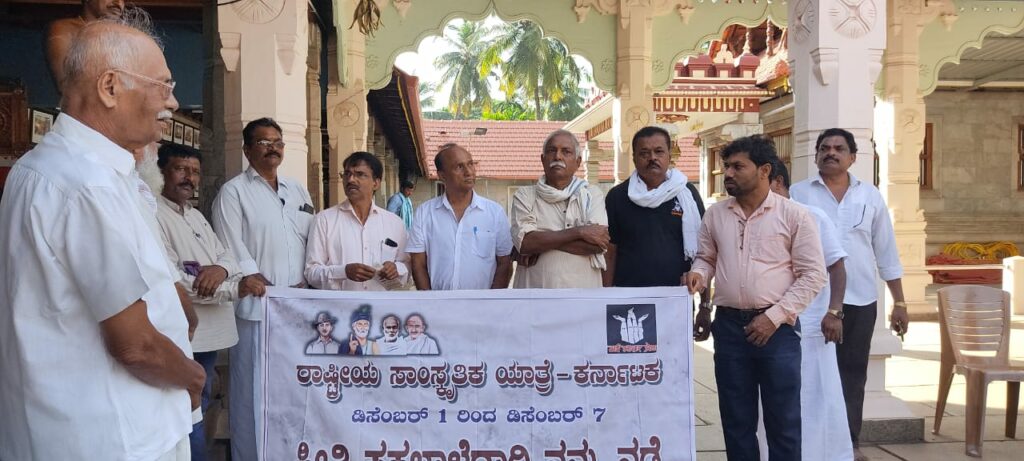
The programme at the Kshetra was organised by the managing committee of the Kshetra, led by Sri Chittaranjan, Sri Kishore Kumar and Sri Hemanth Kumar, with the active participation of the local youth. The participants of the Jatha were warmly welcomed by the management committee. A special darshan of the Gandhi idol was arranged for the Yatris. The chief priest explained the significance of the temple complex and the rituals held there.
Praveen Kumar and Mamatha sang Gandhi Bhajans. Vani Periodi, theatre and rights activist, presented Gandhi Kathana.
10.00am – Sri Vaidyanatha Daivasthana, Karmistan:
After walking along the paddy fields, the Jatha reached Sri Vaidyanatha Daivasthana, Karmistan.
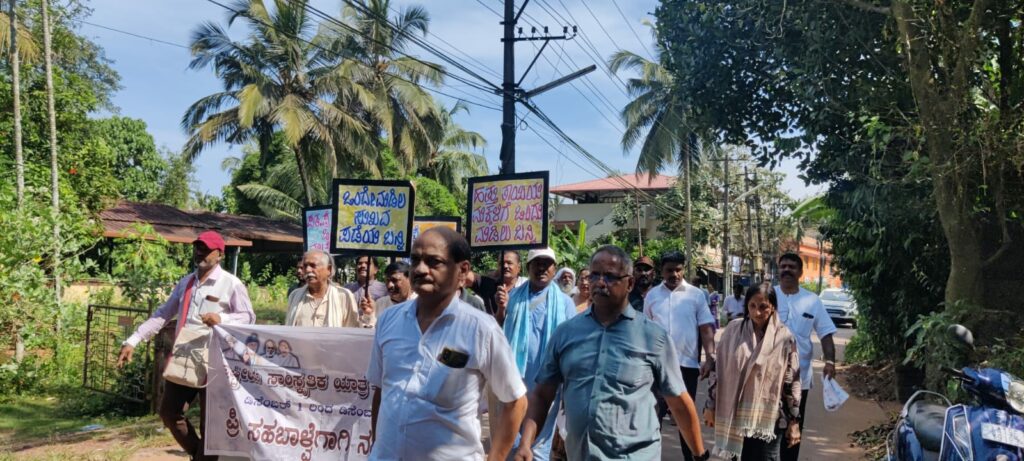 Along the route, songs of love, harmony and patriotism were sung by the participants. Jeppinamogaru and Karmistan were the lands where workers’ and peasants’ movements in the fifties and sixties were very vibrant. Along the route, tributes were paid to the leaders of yesteryears such as Lingapoa Suvarna, Simpson Soans, Narayan Mysore, Monappa Shetty and others.
Along the route, songs of love, harmony and patriotism were sung by the participants. Jeppinamogaru and Karmistan were the lands where workers’ and peasants’ movements in the fifties and sixties were very vibrant. Along the route, tributes were paid to the leaders of yesteryears such as Lingapoa Suvarna, Simpson Soans, Narayan Mysore, Monappa Shetty and others.
The programme at the Sri Vaidyanatha Daivasthana was organised by the managing committee in association with Jeppinamogaru Yuvaka Mandal. Sri Prabhakar Shriyan, Sri Nagednra, Corporator, Sri MG Hegde, and Sri Premchand, former corporator.
At the Sri Vaidyanatha Daivasthana, Sri Bhujanga Shetty, the elder at the temple, explained the traditions of the Daivasthana and narrated its links with the Natha sect, and explained how the rituals are deeply intertwined with the agricultural practices and how the local deity is the supreme force in the area. Prasanna, speaking on the occasion, reminded the need to understand these local customs and work in unison with them for a more harmonious existence, preserving the rural traditions and practices. Refreshments were provided by the management committee.
10.40am The Jatha participants paid a visit to the decades old office of Jeppinamogaru Yuvaka Mandal. Sri MG Hegde, member of the reception committee who had volunteered to organise the programmes at Jeppinamogaru, introduced the office bearers of the Yuvaka Mandal and briefly narrated their activities in the area, while thanking them for their help.
11.20am – Late Sri Jeppu Ramappa Memorial.
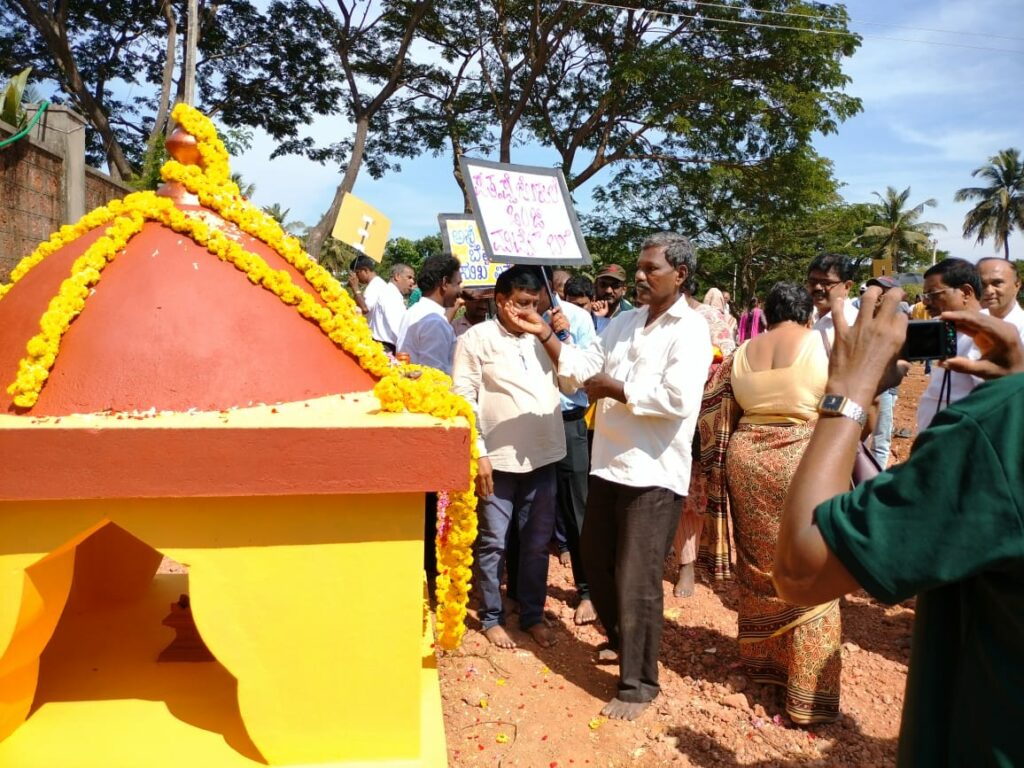
 Late Sri J. Ramappa was a philanthropist who fed and helped the poor and was associated with many religious and cultural activities in the city. The Jatha was welcomed by the family members of Sri Ramappa, led by Sri Nagendra and Mr Sony. The memorial had been spruced up and decorated for the visit, under the guidance of Sri Suresh Kumar, and Mr Sony. The Yatris, led by Prasanna, Dr. Siddanagouda Patil, and Dr. Sabiha Bhoomigowda, paid floral tributes at the memorial.
Late Sri J. Ramappa was a philanthropist who fed and helped the poor and was associated with many religious and cultural activities in the city. The Jatha was welcomed by the family members of Sri Ramappa, led by Sri Nagendra and Mr Sony. The memorial had been spruced up and decorated for the visit, under the guidance of Sri Suresh Kumar, and Mr Sony. The Yatris, led by Prasanna, Dr. Siddanagouda Patil, and Dr. Sabiha Bhoomigowda, paid floral tributes at the memorial.
The participants were ushered by the family members into the old, grand, traditional village house of late Sri Ramappa. Speaking in front of the house, Sri MG Hegde narrated how Sri Ramappa had fed thousands of people with meals of unlimited portions at a very reasonable price and thereby had supported the working people, stressing that rice, or food, played a major role in maintaining social relationships. Dr Uday Kumar Irvathur recollected how many of his batch mates from poor families were helped by Sri Ramappa to continue their education. Prasanna spoke about examples of persons such as Ramappa who served the people in all sincerity, yet remained simple and away from any glory.
The Yatris were treated with Sajjige-Bajil, fondly called ‘concrete’ in local jargon, and tea. This mixture of upma and spiced beaten rice is the traditional breakfast of the working class, and poetically represents a mixture of the divergent dishes that stays strong when mixed together.
12.30 pm Herbert D Souza’s farm
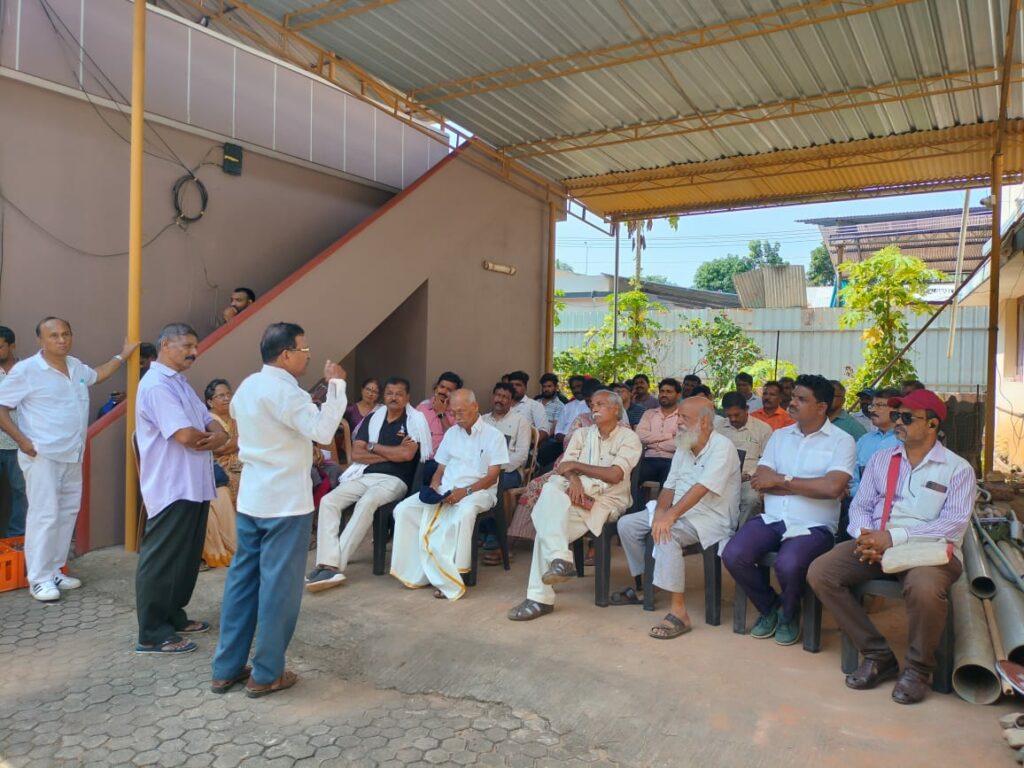
Herbert D Souza is a progressive farmer, who provides rice spikes freely for the new harvest festival of the Christian community as well as festivals at various temples in and around Mangaluru, thereby symbolising the traditional bonding and shared heritages between communities. The Jatha participants interacted with Mr D’Souza and appreciated his generosity.
2.30pm Crossing over to Harekala

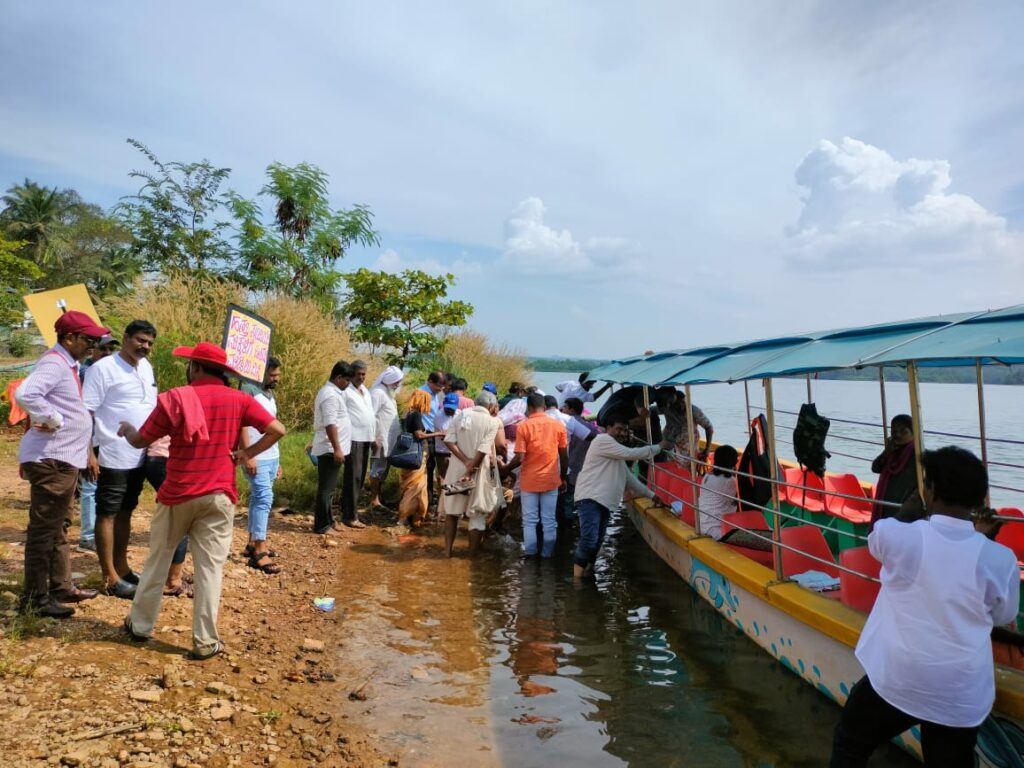

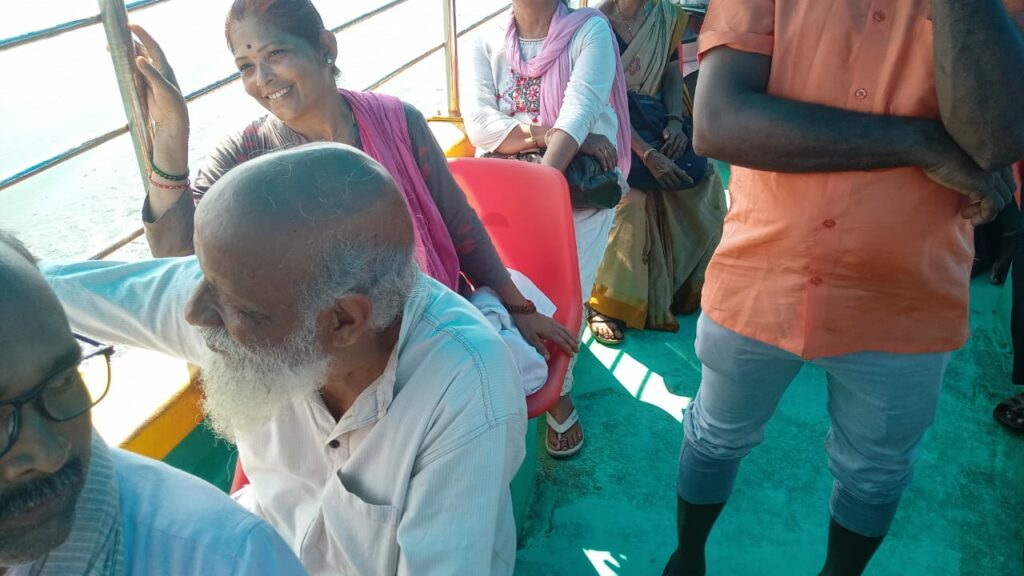 The Jatha walked to the bank of Netravathi river at Kadekar- Jeppinamogaru and got into the boat arranged by Gregory D’Souza. Holding the banner and placards and singing songs, the Yatris had a memorable boat journey across the river, beneath its kilometre long bridge and passing around the islets with mangroves, to reach Harekala on the other side.
The Jatha walked to the bank of Netravathi river at Kadekar- Jeppinamogaru and got into the boat arranged by Gregory D’Souza. Holding the banner and placards and singing songs, the Yatris had a memorable boat journey across the river, beneath its kilometre long bridge and passing around the islets with mangroves, to reach Harekala on the other side.
3.30pm Maimuna Dairy, Harekala


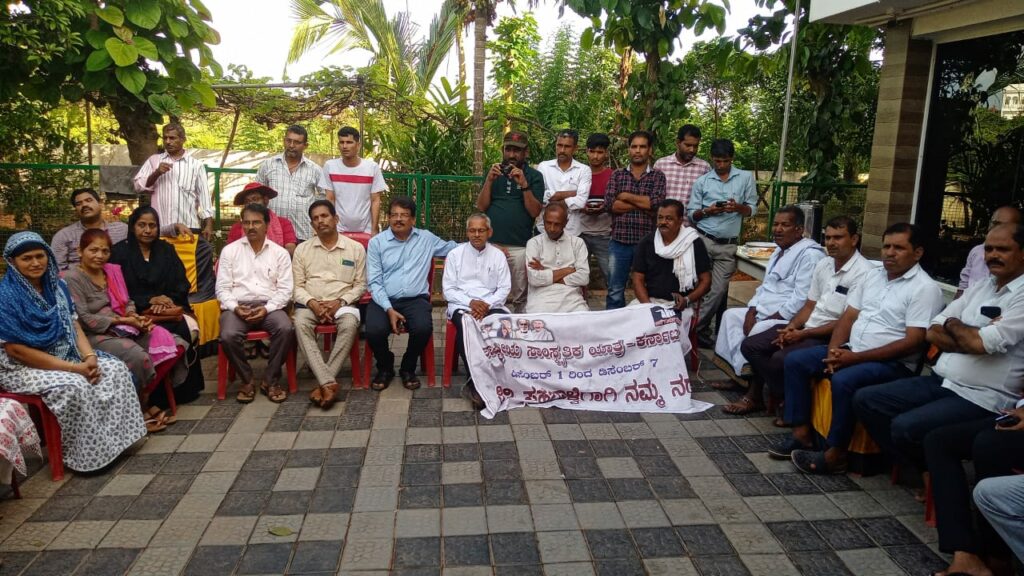

 The Yatris are warmly welcomed at the Maimuna Dairy by Smt Maimuna, her family members and the staff. They were treated to sumptuous meals. Thereafter, Mrs. Maimuna and daughter Mergin explained the origins and development of the Dairy, narrating how from a state of penury and rolling beedies to eke out their living, and after the passing of Maimuna’s husband, they worked over the past 4 years to realise his dream of rearing cattle, and with hardwork and dedication, could build the farm that now has 62 cows, and has become a model of rural entrepreneurship, creating employment for many youth. They are donating nearly half of their profits to social causes, for feeding and educating the poor and are working to soon increase the number of cattle to 100 and have plans to establish institutions to help the needy. Prasanna, Dr Siddanagouda Patil, Dr Sabiha, Amjad and other participants participated in the interactions.
The Yatris are warmly welcomed at the Maimuna Dairy by Smt Maimuna, her family members and the staff. They were treated to sumptuous meals. Thereafter, Mrs. Maimuna and daughter Mergin explained the origins and development of the Dairy, narrating how from a state of penury and rolling beedies to eke out their living, and after the passing of Maimuna’s husband, they worked over the past 4 years to realise his dream of rearing cattle, and with hardwork and dedication, could build the farm that now has 62 cows, and has become a model of rural entrepreneurship, creating employment for many youth. They are donating nearly half of their profits to social causes, for feeding and educating the poor and are working to soon increase the number of cattle to 100 and have plans to establish institutions to help the needy. Prasanna, Dr Siddanagouda Patil, Dr Sabiha, Amjad and other participants participated in the interactions.
5.00pm
After walking through the Harekala Panchayat Office, the Yatris visited the New Padpu School, built by Akshara Santa (saint of letters) Padmashri Harekala Hajabba. Being illiterate and a fruit seller, Sri Harekala Hajabba built the school in his village to ensure education for the children there. It was indeed an enriching experience for all the Yatris to visit this school.
Overnight stay and food for the Yatris was arranged by a well wisher of Natekal.
Day 3- Dec 4, Monday
9.30am – Interaction with students at Natekal
The day started with interaction with more than 500 students of the High School at Natekal. Prasanna spoke about the connections between the cosmic supreme transcending to families and interpersonal relationships and how over the years these relationships have been changing. He urged the students to be grounded, compassionate, follow their dreams and connect with reality rather than modern machines. Dr Siddanagouda Patil and others also participated in the interactions and the IPTA Yatris sang songs of love and peaceful co-existence.
11.00am – Mangalagangothri – Mangalore University
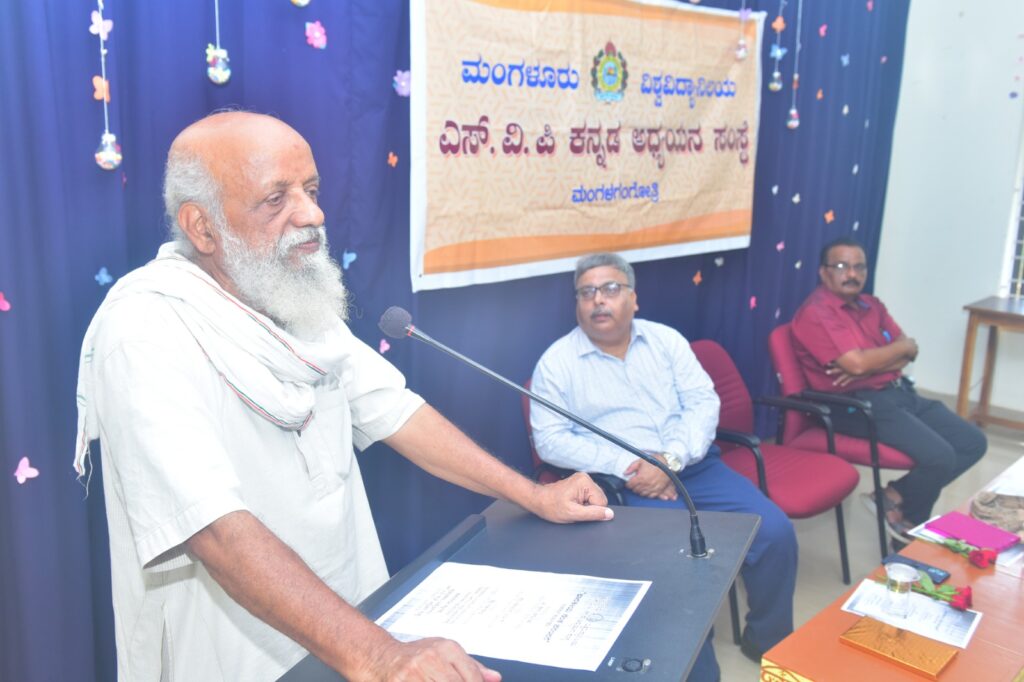
 The SVP Kananda Study Centre of Mangalore University arranged a lecture – interaction by Prasanna on Bharatiya Saint Traditions. Prof. Jayaraj Amin, in-charge vice chancellor, presided. Pro. Somanna, Chairman of SVP Kananda Study Center graced the occasion. Prof. Sabiha Bhoomigowda, Prof. Shivaram Shetty, other faculty and students attended the programme.
The SVP Kananda Study Centre of Mangalore University arranged a lecture – interaction by Prasanna on Bharatiya Saint Traditions. Prof. Jayaraj Amin, in-charge vice chancellor, presided. Pro. Somanna, Chairman of SVP Kananda Study Center graced the occasion. Prof. Sabiha Bhoomigowda, Prof. Shivaram Shetty, other faculty and students attended the programme.
11.30am – Asaigoli: Interaction about co-operative movement
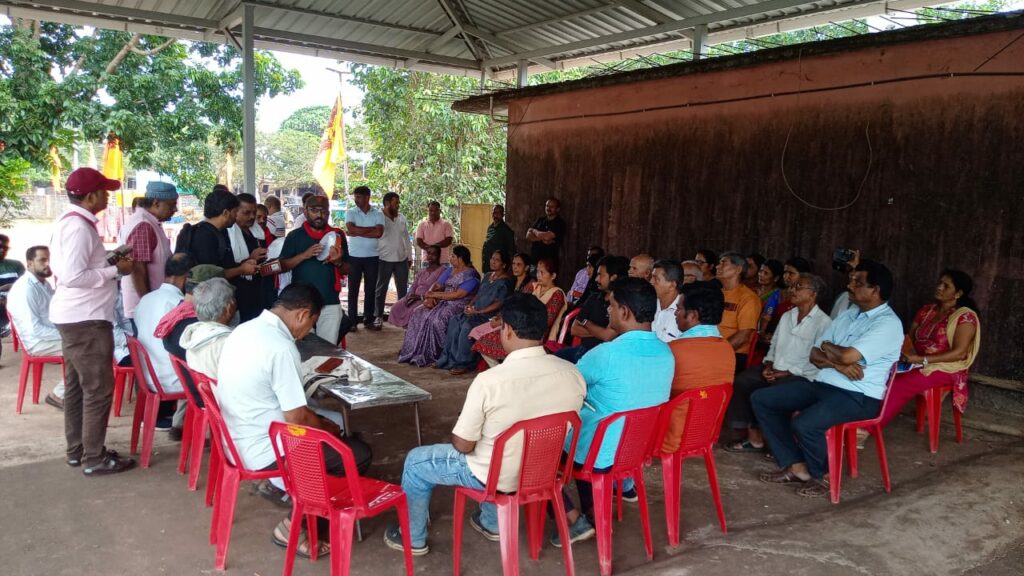 The Jatha walked to Asaigoli, where Shoukath Ali, former president of Konaje Gram Panchayath had organised an interaction with the members and office bearers of Konaje Consumers’ Co-operative Society and Milk Producers Co-operative of Women, as well as ASHA workers of Konaje area. Dr Siddanagouda Patil, Amjad, Shanmukhaswamy and others participated in the interaction.
The Jatha walked to Asaigoli, where Shoukath Ali, former president of Konaje Gram Panchayath had organised an interaction with the members and office bearers of Konaje Consumers’ Co-operative Society and Milk Producers Co-operative of Women, as well as ASHA workers of Konaje area. Dr Siddanagouda Patil, Amjad, Shanmukhaswamy and others participated in the interaction.
4.00pm Konaje Yuvaka Mandala
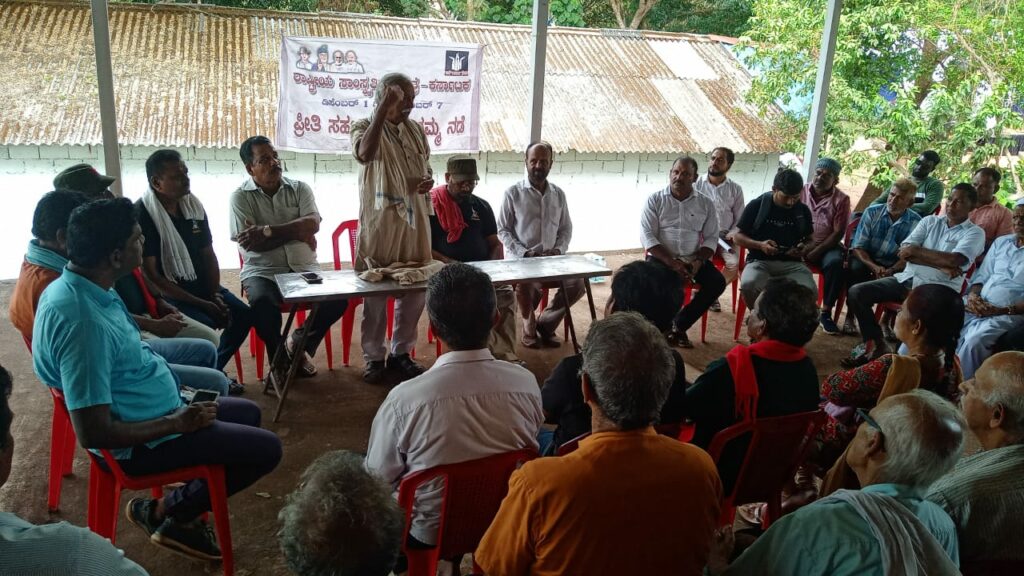 An interaction with youth was organised under the aegis of Konaje Yuvaka Mandala by Sri Ibrahim Kodijal, prominent social activist of the district. Dr Siddanagouda Patil, Amjad, Shanmukhaswamy and others participated in the interaction.
An interaction with youth was organised under the aegis of Konaje Yuvaka Mandala by Sri Ibrahim Kodijal, prominent social activist of the district. Dr Siddanagouda Patil, Amjad, Shanmukhaswamy and others participated in the interaction.
Day 4 – Dec 5, Tuesday
9.30 am-1pm – Mudipu Jana Shikshana Trust




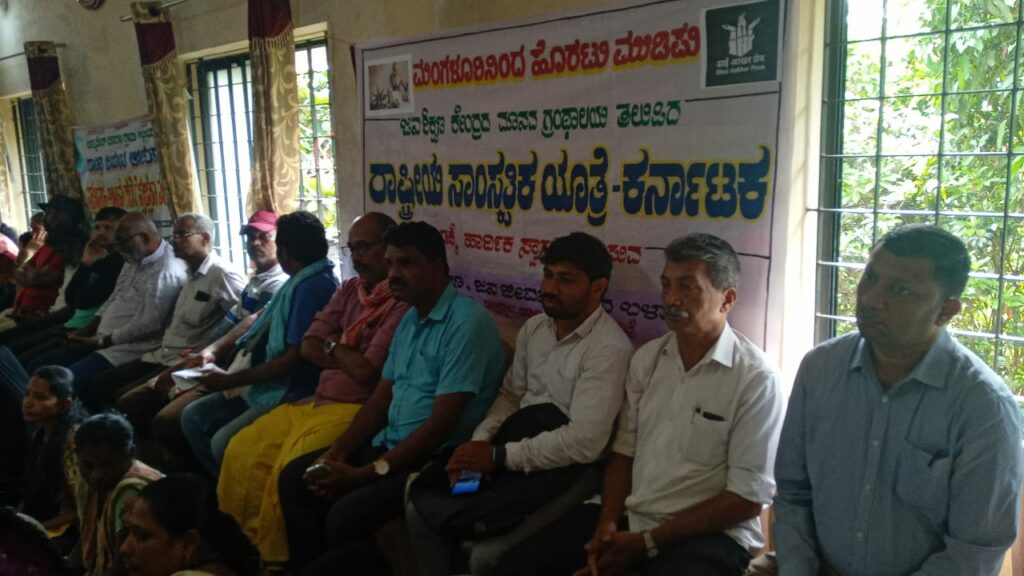

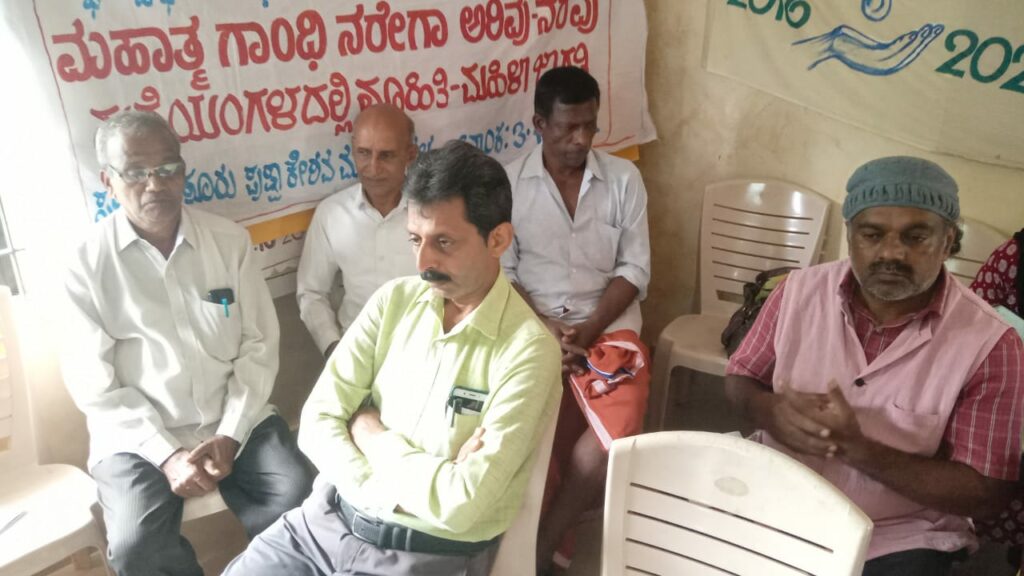
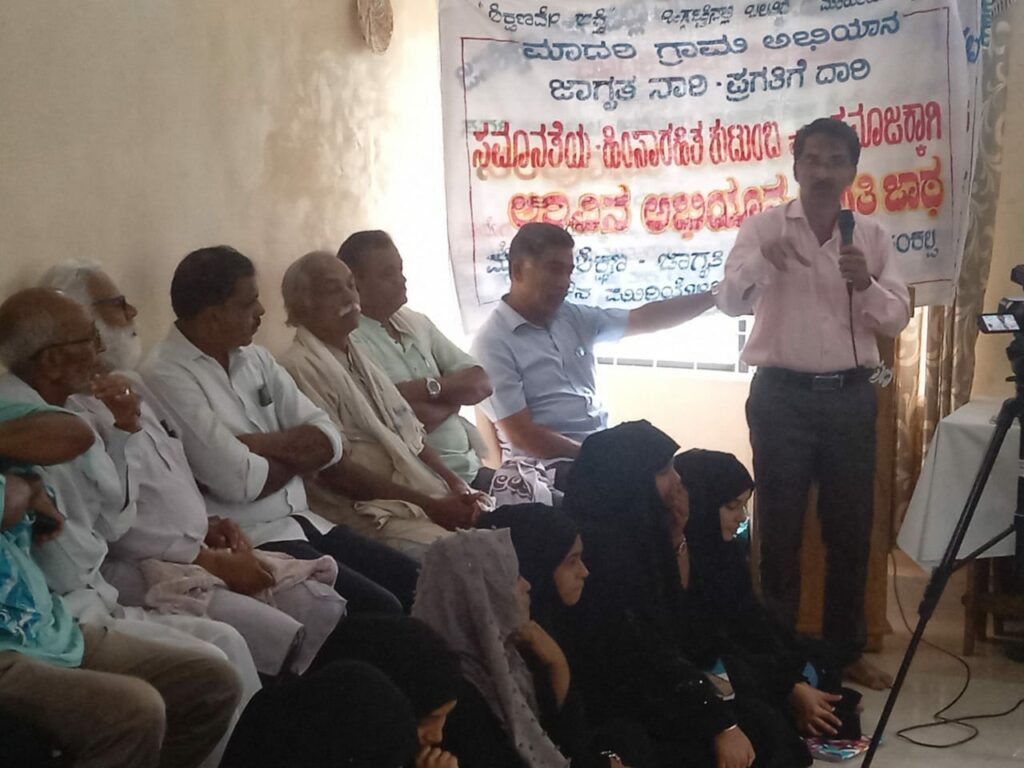
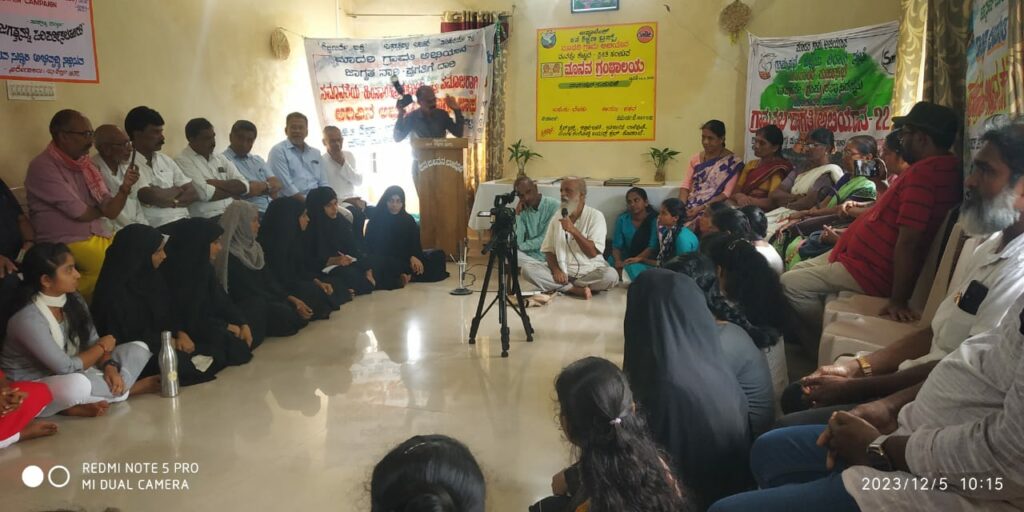
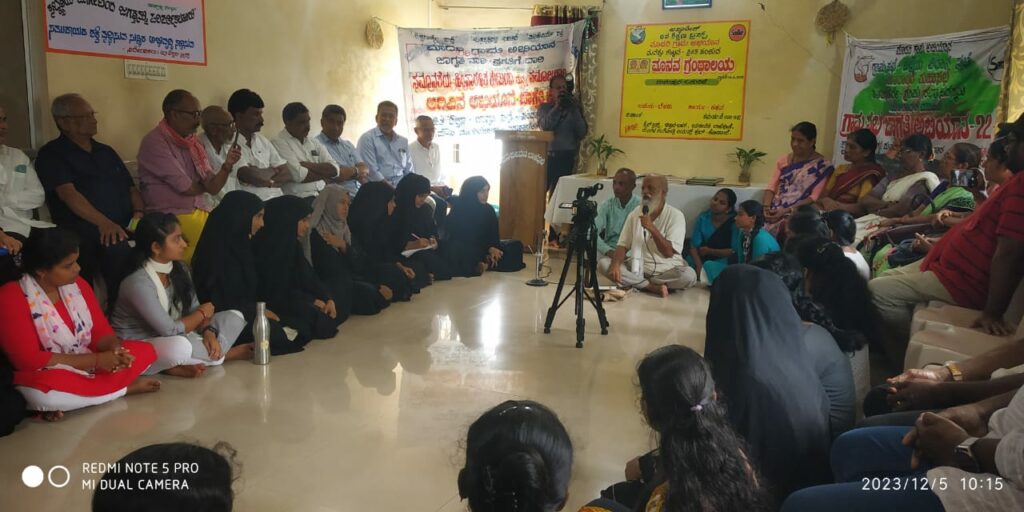 Jana Shikshana Trust, Mudipu has been doing tremendous work among the rural masses, particularly among the most backward Koraga tribal community and for women’s empowerment since years. The Dhai Aakhar prem Jatha was welcomed by the Nalike (folk dance) Troupe, led by Aboobakar Jalli and Sudhir Balepuni, with the bets of dhol and dudi. Sheena Shetty, coordinator of Jana Shikshana Trust, formally welcomed the Yatris and introduced the activities of the Trust. The members and beneficiaries presented the details of their activities, demonstrated their skills and also performed songs. Prasanna, Dr Siddanagaouda Patil and other Yatris participated in the interactions. Krishna Moolya, also a coordinator of Jana Shikshana Trust, conducted the proceedings. Chandrashekhar Pathoor, Satish Ira and Nagesh Kallur of Chittaara Balaga had arranged the refreshments, and the lunch was hosted by Ramesh Shenava of Janajeevana, Balepuni. Shivaprasad Alva, Ibrahim Tapsya and Hyder Kairangala helped in coordinating this programme.
Jana Shikshana Trust, Mudipu has been doing tremendous work among the rural masses, particularly among the most backward Koraga tribal community and for women’s empowerment since years. The Dhai Aakhar prem Jatha was welcomed by the Nalike (folk dance) Troupe, led by Aboobakar Jalli and Sudhir Balepuni, with the bets of dhol and dudi. Sheena Shetty, coordinator of Jana Shikshana Trust, formally welcomed the Yatris and introduced the activities of the Trust. The members and beneficiaries presented the details of their activities, demonstrated their skills and also performed songs. Prasanna, Dr Siddanagaouda Patil and other Yatris participated in the interactions. Krishna Moolya, also a coordinator of Jana Shikshana Trust, conducted the proceedings. Chandrashekhar Pathoor, Satish Ira and Nagesh Kallur of Chittaara Balaga had arranged the refreshments, and the lunch was hosted by Ramesh Shenava of Janajeevana, Balepuni. Shivaprasad Alva, Ibrahim Tapsya and Hyder Kairangala helped in coordinating this programme.
4pm: Bangaragudde – Interaction with Bhaira Community
The Jatha walked along the rural remote area to reach Bangaragudde, the abode of Bhaira community. Dr. Siddanagouda Patil, Shanmukhaswamy, CN Gundanna of Samudaya Karnataka, and other participants interacted with the tribals.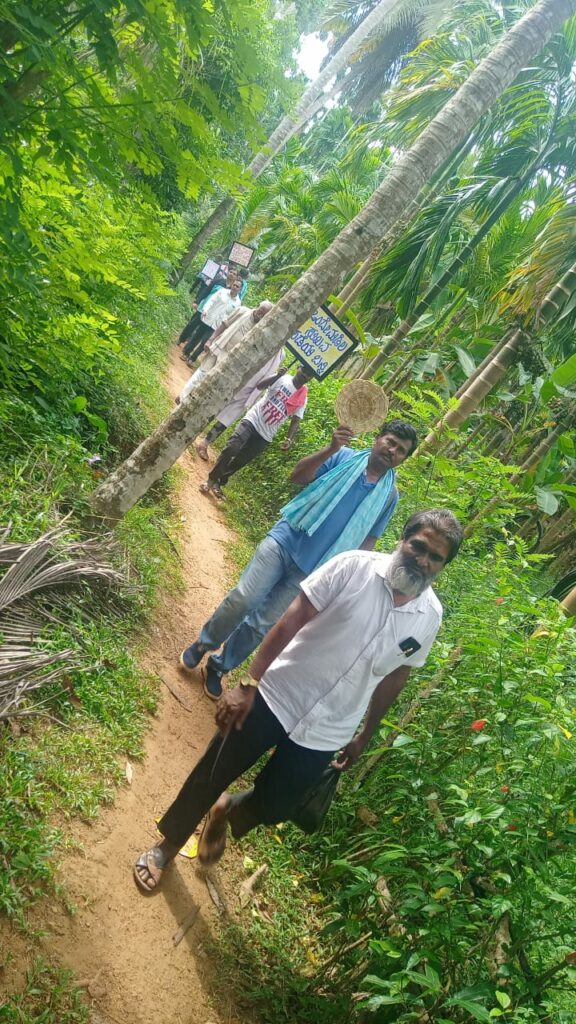

5.30pm – Kulala Sangha, Kurnad, Mudipu
 At the Kulal Bhavan, Kurnad, tributes were paid at the centenary memorial of late Dr. Ammembal Balappa, a freedom fighter, Gandhian and social activist. Sri Ravindranath, a relative of Dr Balappa and Tejaswi Raj, grandson of Dr Balappa, spoke about Dr Balappa’s life and work. Pundarikaksha Moolya, President of Kulala Sangha presided.
At the Kulal Bhavan, Kurnad, tributes were paid at the centenary memorial of late Dr. Ammembal Balappa, a freedom fighter, Gandhian and social activist. Sri Ravindranath, a relative of Dr Balappa and Tejaswi Raj, grandson of Dr Balappa, spoke about Dr Balappa’s life and work. Pundarikaksha Moolya, President of Kulala Sangha presided.
Thereafter, members of Potters’ Cooperative Society, Puttur, presented a demonstration on pottery. Mayur Ullal, president of Dakshina Kannada Kulal Association, Bhaskar M Peruvai and Janardha, president and ECO respectively of Potters’ Cooperative Society, Puttur, conducted an interactive session on challenges and opportunities of pot making. Prasanna, Dr Siddanagouda Patil and others participated.
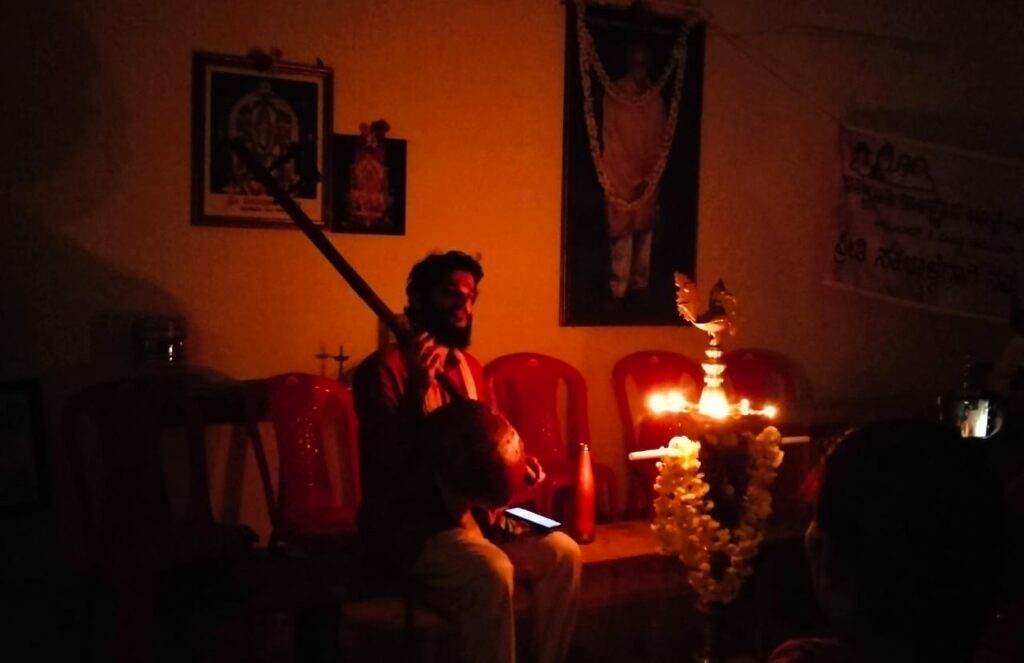 This was followed by Kattala Hadugalu (Songs of the Night) Performance by well known singer-performer Nada Maninalkoor.
This was followed by Kattala Hadugalu (Songs of the Night) Performance by well known singer-performer Nada Maninalkoor.
Day 5 – Dec 6, Wednesday
10am Hoohakuva Kallu
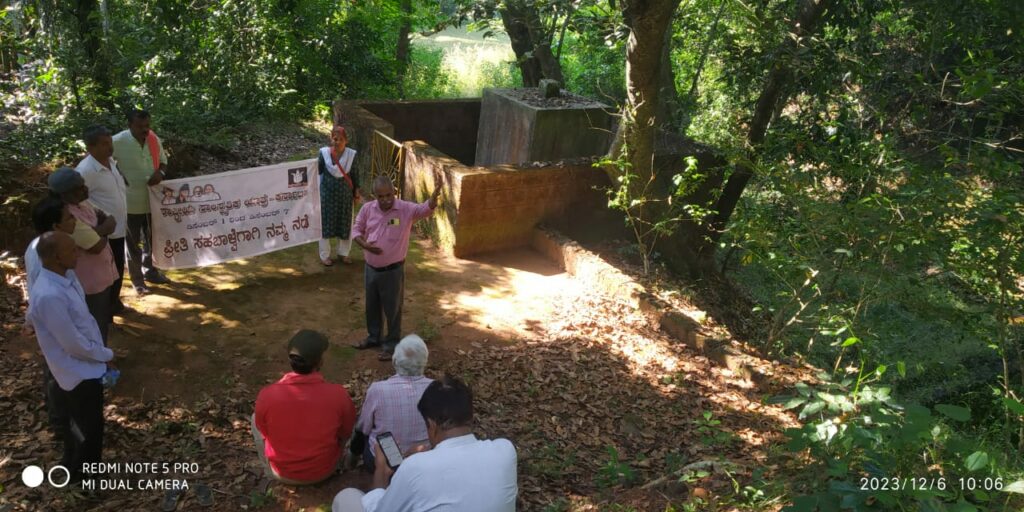
 The Jatha resumed at Hoohakuva Kallu (‘flower throwing stone’) near Mudipu by visiting the temple of flower throwing stone. Legend has it that the Daiva (Deity) at Kananthoor came down to the coastal region from the hills atop and first sat on this stone, before settling down in Kananthoor.
The Jatha resumed at Hoohakuva Kallu (‘flower throwing stone’) near Mudipu by visiting the temple of flower throwing stone. Legend has it that the Daiva (Deity) at Kananthoor came down to the coastal region from the hills atop and first sat on this stone, before settling down in Kananthoor.
11.30am Kananthoor Sri Thodukukkinar Daivasthana



 The Jatha proceeded to Kananthoor Sri Thodukukkinar Daivasthana, which according to legends, has the daivas (deities) that depict the struggles and triumphs of women. The Jatha was welcomed by the Managing Trustee of the Kshetra Sri Deviprasad Poyyathabail. The Kantha of the Daivasthana presented the Pad-dana or folklore narrating the legend behind the deities of the Daivasthana. Chandrahas Kananthoor deciphered it and explained the legend as well as the rituals around it. A mango tree supposedly more than 800 years old that is standing tall at the premises was shown by Sri Deviprasad Poyyathabail who explained that not even a leaf is cut from that tree and it is left at its natural splendour. Interactions centered around rural issues, beliefs and sustainable development. Lunch was hosted for all the participants on behalf of the managing trustee and managing committee.
The Jatha proceeded to Kananthoor Sri Thodukukkinar Daivasthana, which according to legends, has the daivas (deities) that depict the struggles and triumphs of women. The Jatha was welcomed by the Managing Trustee of the Kshetra Sri Deviprasad Poyyathabail. The Kantha of the Daivasthana presented the Pad-dana or folklore narrating the legend behind the deities of the Daivasthana. Chandrahas Kananthoor deciphered it and explained the legend as well as the rituals around it. A mango tree supposedly more than 800 years old that is standing tall at the premises was shown by Sri Deviprasad Poyyathabail who explained that not even a leaf is cut from that tree and it is left at its natural splendour. Interactions centered around rural issues, beliefs and sustainable development. Lunch was hosted for all the participants on behalf of the managing trustee and managing committee.
4.00 pm Poyyathabail Juma Masjid and Manavati Beevi Darga
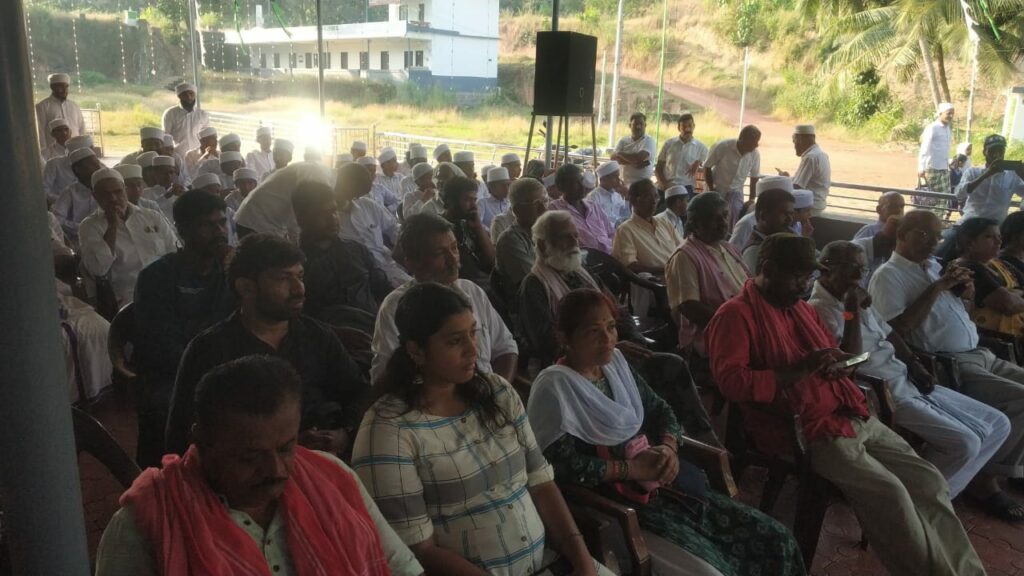
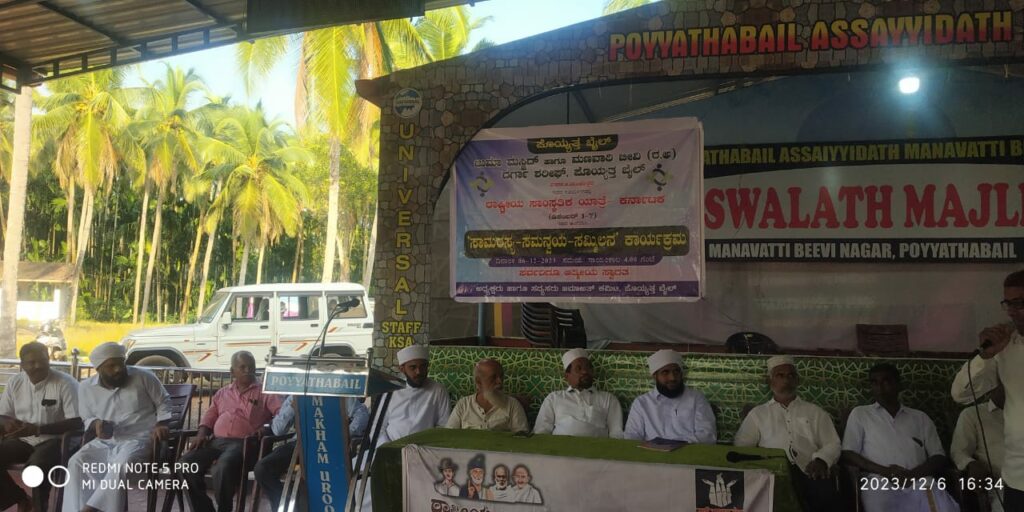

 The Yatris traversed through paddy fields and reached the Poyyathabail Juma Masjid and Manavati Beevi Darga. These very old shrines attract people across religions, Manavati Beevi being treated by all as a saviour of the poor and the downtrodden.
The Yatris traversed through paddy fields and reached the Poyyathabail Juma Masjid and Manavati Beevi Darga. These very old shrines attract people across religions, Manavati Beevi being treated by all as a saviour of the poor and the downtrodden.
The Yatris were welcomed by Ismail T on behalf of the management committee of the Masjid and local people. The students gave a ceremonial reception to the Yatris. Dr Ismail explained the centuries old traditions at these shrines, depicting the syncretic cultures of the region that reflect peaceful coexistence and harmony. Prasanna appreciated the harmonious and peaceful living of the people of different religions, languages and cultures at this border area between Karnataka and Kerala and said that the saints and Sufis transcended religions and sects to help the poor and the needy. The programme was coordinated by Dr Ismail N.
Day 6 – Dec 7, 2023
10.30am
Arasu Manjishnar Temple Mada and Thousand Jamat Masjid, Udyavara.

 The Arasu Manjishnar Temple Mada and Thousand Jamat Masjid, Udyavara are standing testimony for nearly 900 years for harmonious coexistence and shared heritages and practices. The annual rituals at these shrines involve the elders of both the shrines, one not happening without the presence of the other.
The Arasu Manjishnar Temple Mada and Thousand Jamat Masjid, Udyavara are standing testimony for nearly 900 years for harmonious coexistence and shared heritages and practices. The annual rituals at these shrines involve the elders of both the shrines, one not happening without the presence of the other.
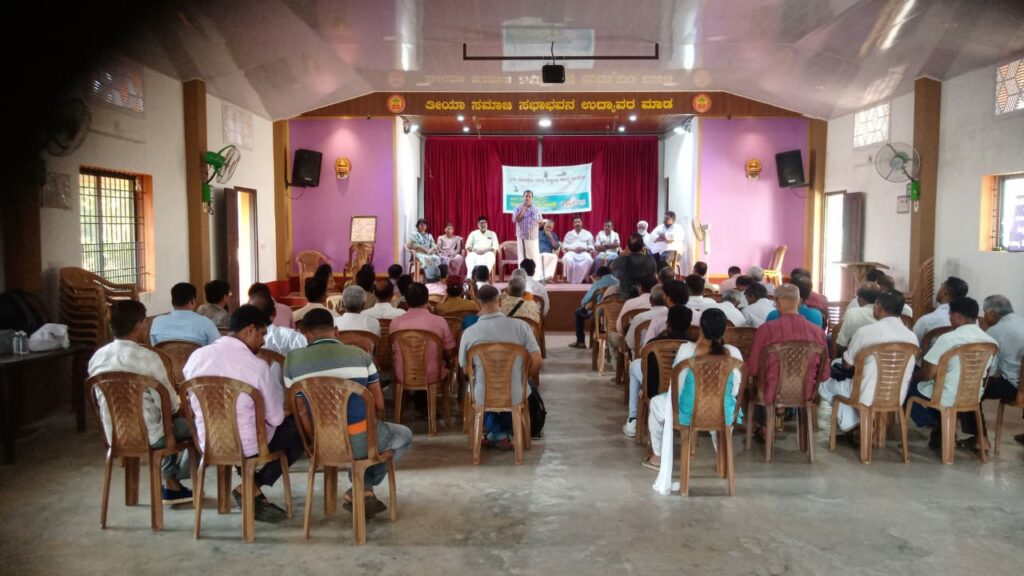
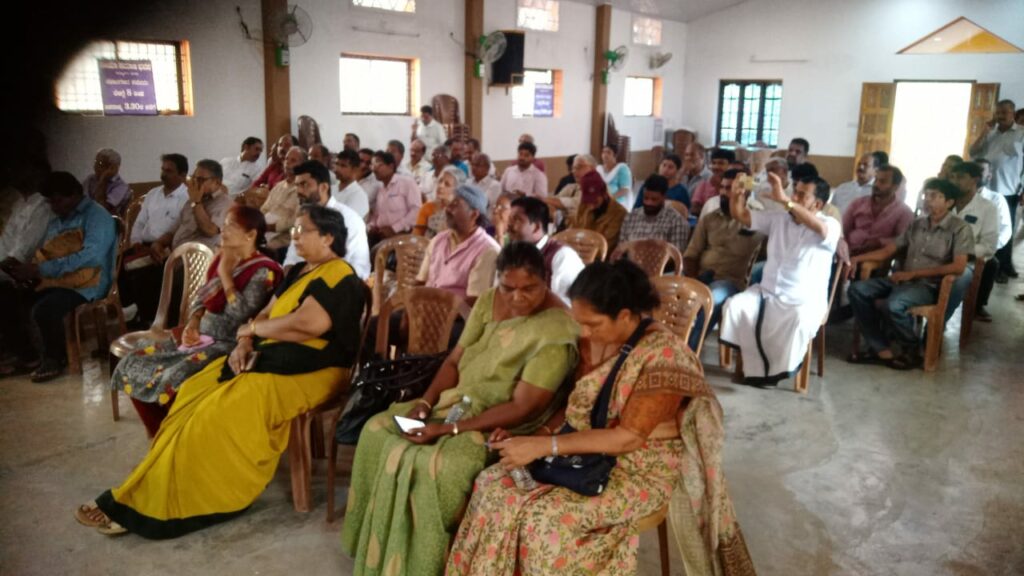

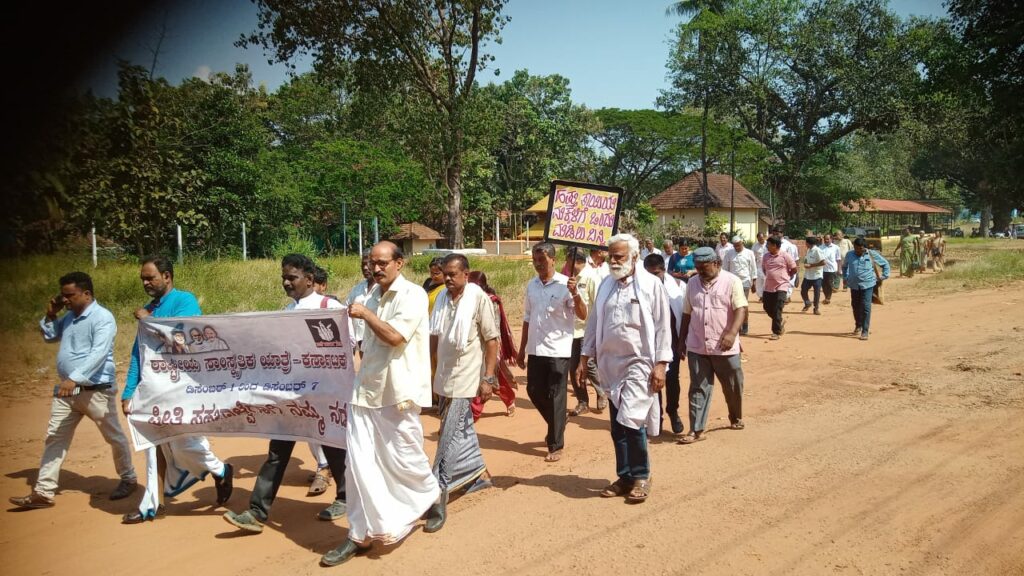

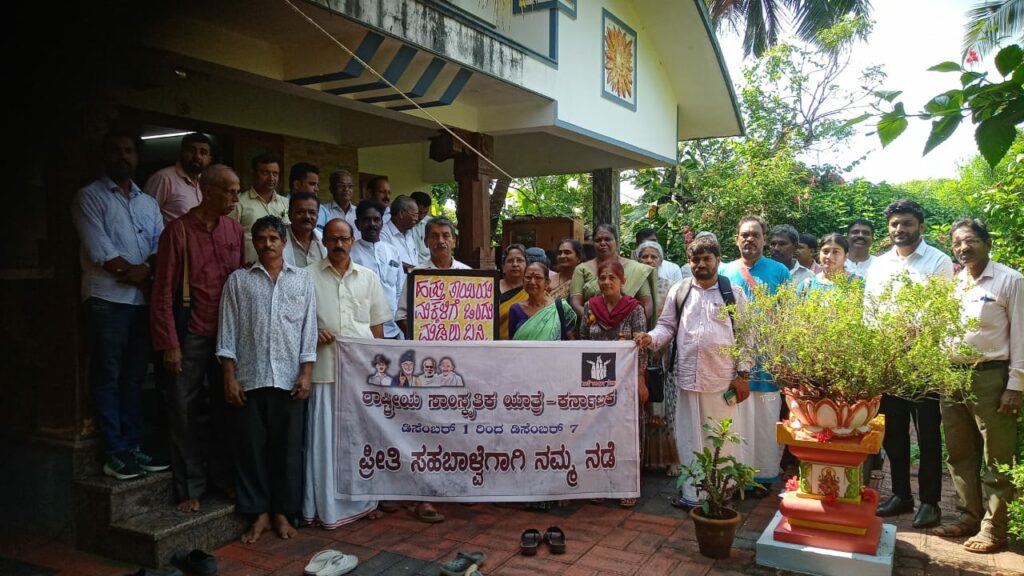


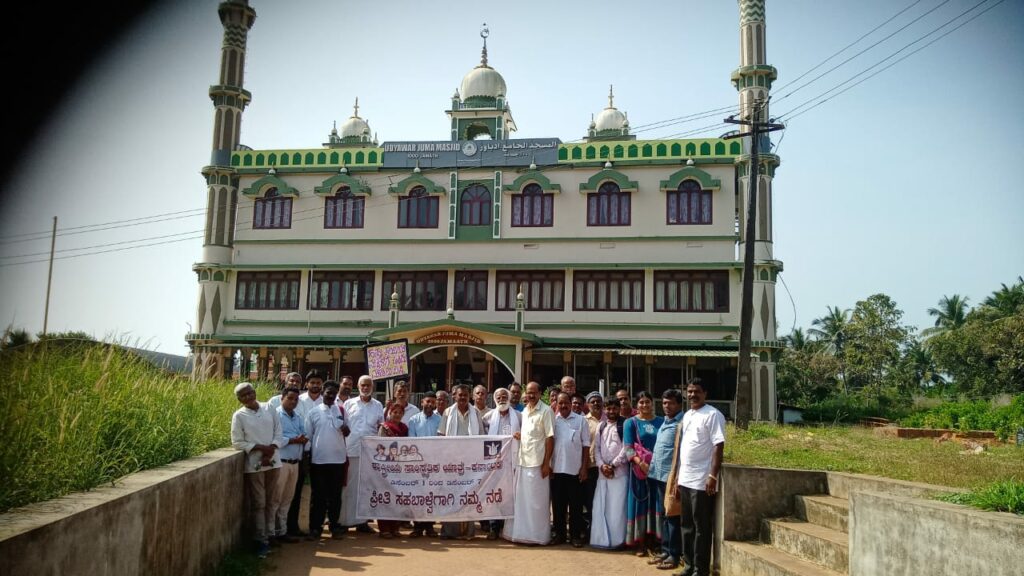
For the annual ritual at the temple, the head of rituals invites the members of the masjid and on the day of the festival, the Daiva Patri along with the heads of daivasthana and ten community leaders go in a procession to the masjid, where they are accorded a warm welcome and treated with utmost respect by the masjid committee. And for the festivals at the masjid, the temple officials send grains and other materials to the masjid.
When the Yatra reached the Arasu Manjishna temple, the temple trustees, elders and the reception committee for teh Yatra welcomed them. BV Rajan welcomed the Yatris on behalf of the reception committee. The rituals at the temple were explained by the priests of the temple as well as by the elders of the masjid. Refreshments were provided to the yatris.
11.30am Surendra Kotyan’s Library
Surendra Kotyan, a book lover, has collected over 10000 books worth more than Rs 10 lakhs at his own expense and developed a library in this village. The Yatris visited the library and appreciated his single-handed efforts to spread knowledge to his people.
12.00noon
The Yatra thereafter reached the Udyavara Thousand jamat Masjid. Moyiuddin, former secretary of the masjid, who had taken a very keen interest in organising the events at both the temple as well the mosque, explained the functioning of the mosque and about the syncretic cultures and shared rituals of the two shrines. He also explained about the educational activities conducted by the masjid, particularly for girls. The masjid committee provided food and refreshments for the yatris.
2.30pm




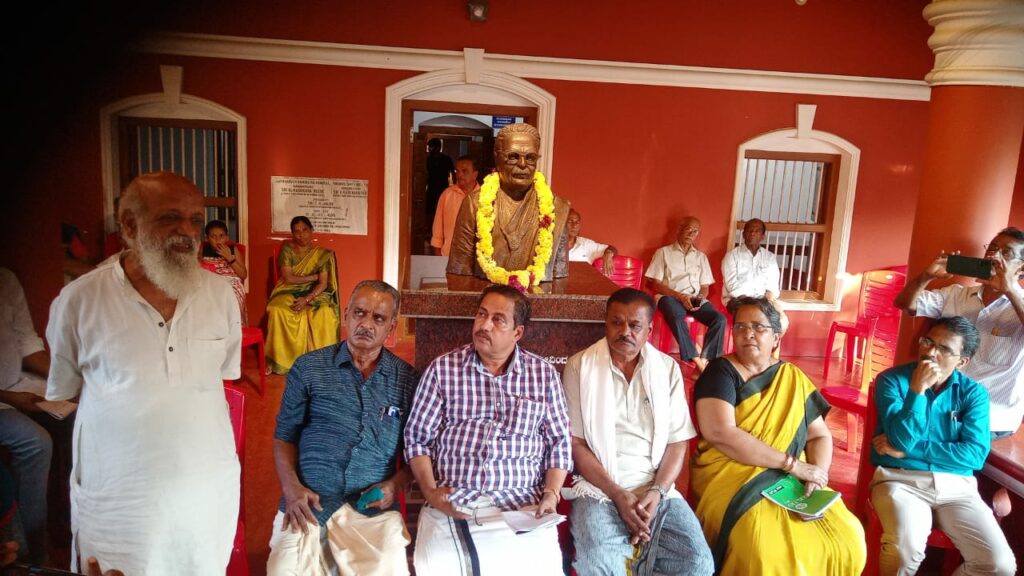

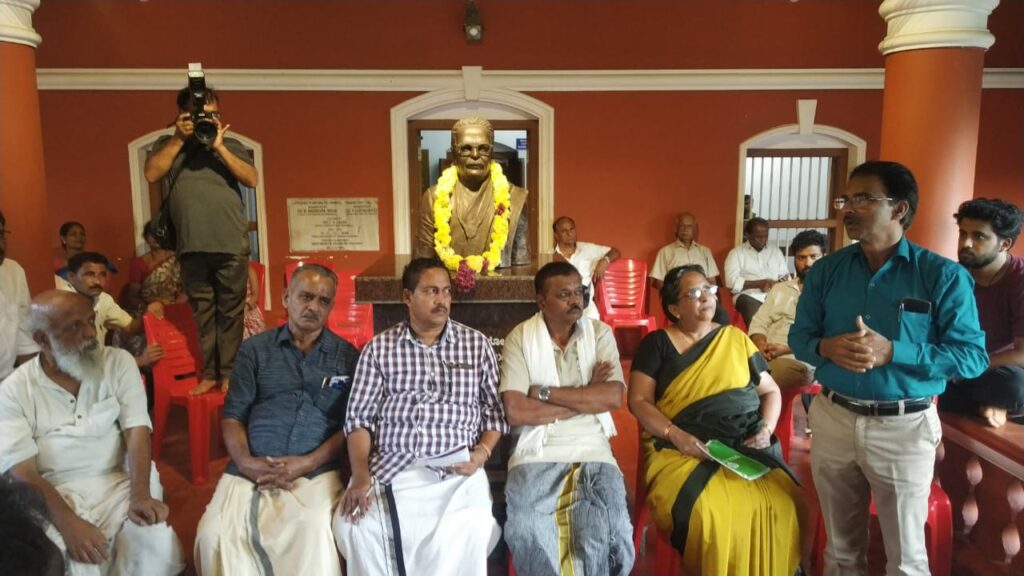 The Dhai Aakhar Prem Jatha reached its final destination Gilivindu. It is the cultural centre set up in memory of Rashtrakavi M. Govinda Pai at his then residence near Manjeshwaram in Kasargod, Kerala. Sri Govind Pai was a prolific writer and a polyglot, honoured as the first Rashtra Kavi of Kannada in 1949.
The Dhai Aakhar Prem Jatha reached its final destination Gilivindu. It is the cultural centre set up in memory of Rashtrakavi M. Govinda Pai at his then residence near Manjeshwaram in Kasargod, Kerala. Sri Govind Pai was a prolific writer and a polyglot, honoured as the first Rashtra Kavi of Kannada in 1949.
The Yatris were welcomed by Jayananda, Chairman of the reception committee, BV Rajan, coordinator of the reception committee, and Umesh Salian, Secretary of Gilivindu. After lunch, at 4.00pm, the valedictory programme of the 6 day jatha was held in front of the bust of M Govinda Pai.
Jayanada presided over the programme, welcomed everyone and conducted the proceedings. Balan, president of IPTA, Kerala state unit, spoke in appreciation of the jatha. Prasanna, in his concluding remarks, explained how the working class is fast disappearing with the increasing use of machines and artificial intelligence, posing grave challenge to the very fabric of social and family relationships, besides making the working class unity and movements redundant and ineffective. Dr Sabiha Bhoomigowda, quoting a Kananda adage Kosha Odu, Desha Suttu, meaning, read encyclopaedias, go around the country, and narrated how the 6 day jatha has enriched every participants life by providing knowledge and experience that could never have been gained from any books. Nagesh Kallur explained how the entire jatha was organised by collective effort of everyone, and how it was self-financed by the enthusiastic organisers of every local event, and said that the effort has demonstrated that for activities that are meaningful and pro-people, funding from big people or corporates are not even needed.
Later, the trainees who had participated in the theatre workshop conducted by Prasanna at Gilivindu on Dec 6 and 7 presented a play titled Prithvi that was very well appreciated by the viewers.
The six day Dhai Aakar Prem – Pattappe Jōkulu Onjē Matteld National Cultural Jatha from Mangaluru in Karnataka to Manjeshwar in Kerala achieved much more than what was planned and hoped for, truly realising its theme Pattappe Jōkulu Onjē Matteld, with all sections of people, cutting across all divisions, participating very enthusiastically, happily providing all the expenses, food, and accommodation, without any glitches anywhere, without any security by the police, without any untoward incidents or voices of opposition from any quarters. For all the participants, the Jatha has been, and will remain, a most memorable experience to be cherished forever, and is certain to encourage all of them to organise more such programmes to bring our people, their cultures, languages, religions, heritage and knowledge together.
